Visual system
| Visual system | |
|---|---|
 The visual system includes the eyes, the connecting pathways through to the visual cortex and other parts of the brain (human system shown). | |
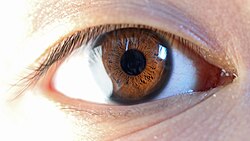 | |
| Identifiers | |
| FMA | 7191 |
| Anatomical terminology | |
The visual system is the physiological basis of
).The visual system performs a number of complex tasks based on the image forming functionality of the eye, including the formation of monocular images, the neural mechanisms underlying
This article describes the human visual system, which is representative of mammalian vision, and to a lesser extent the vertebrate visual system.
System overview

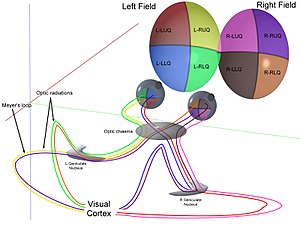
Optical
Together, the
Neural
Most of the optic nerve fibers end in the lateral geniculate nucleus (LGN). Before the LGN forwards the pulses to V1 of the visual cortex (primary) it gauges the range of objects and tags every major object with a velocity tag. These tags predict object movement.
The LGN also sends some fibers to V2 and V3.[8][9][10][11][12]
V1 performs edge-detection to understand spatial organization (initially, 40 milliseconds in, focusing on even small spatial and color changes. Then, 100 milliseconds in, upon receiving the translated LGN, V2, and V3 info, also begins focusing on global organization). V1 also creates a bottom-up
V2 both forwards (direct and via pulvinar) pulses to V1 and receives them. Pulvinar is responsible for saccade and visual attention. V2 serves much the same function as V1, however, it also handles illusory contours, determining depth by comparing left and right pulses (2D images), and foreground distinguishment. V2 connects to V1 - V5.
V3 helps process '
V4 recognizes simple shapes, and gets input from V1 (strong), V2, V3, LGN, and pulvinar.[16] V5's outputs include V4 and its surrounding area, and eye-movement motor cortices (frontal eye-field and lateral intraparietal area).
V5's functionality is similar to that of the other V's, however, it integrates local object motion into global motion on a complex level. V6 works in conjunction with V5 on motion analysis. V5 analyzes self-motion, whereas V6 analyzes motion of objects relative to the background. V6's primary input is V1, with V5 additions. V6 houses the topographical map for vision. V6 outputs to the region directly around it (V6A). V6A has direct connections to arm-moving cortices, including the premotor cortex.[17][18]
The
The suprachiasmatic nucleus is the region of the hypothalamus that halts production of melatonin (indirectly) at first light.[22]
Structure
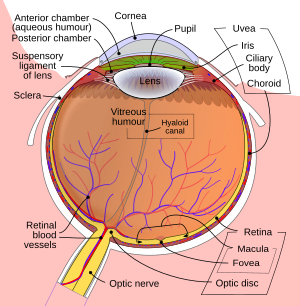
The image projected onto the retina is inverted due to the optics of the eye.
- The eye, especially the retina
- The optic nerve
- The optic chiasma
- The optic tract
- The lateral geniculate body
- The optic radiation
- The visual cortex
- The visual association cortex.
These are components of the visual pathway also called the optic pathway [23] that can be divided into anterior and posterior visual pathways. The anterior visual pathway refers to structures involved in vision before the lateral geniculate nucleus. The posterior visual pathway refers to structures after this point.
Eye
Light entering the eye is
Retina
The retina consists of many
Rods and cones differ in function. Rods are found primarily in the periphery of the retina and are used to see at low levels of light. Each human eye contains 120 million rods. Cones are found primarily in the center (or
In the retina, the photoreceptors
Mechanism of generating visual signals
The retina adapts to change in light through the use of the rods. In the dark, the
The final result of all this processing is five different populations of ganglion cells that send visual (image-forming and non-image-forming) information to the brain:[26]
- M cells, with large center-surround receptive fields that are sensitive to depth, indifferent to color, and rapidly adapt to a stimulus;
- P cells, with smaller center-surround receptive fields that are sensitive to color and shape;
- K cells, with very large center-only receptive fields that are sensitive to color and indifferent to shape or depth;
- another population that is intrinsically photosensitive; and
- a final population that is used for eye movements.[26]
A 2006 University of Pennsylvania study calculated the approximate bandwidth of human retinas to be about 8960 kilobits per second, whereas guinea pig retinas transfer at about 875 kilobits.[29]
In 2007 Zaidi and co-researchers on both sides of the Atlantic studying patients without rods and cones, discovered that the novel photoreceptive ganglion cell in humans also has a role in conscious and unconscious visual perception.[30] The peak spectral sensitivity was 481 nm. This shows that there are two pathways for vision in the retina – one based on classic photoreceptors (rods and cones) and the other, newly discovered, based on photo-receptive ganglion cells which act as rudimentary visual brightness detectors.
Photochemistry
The functioning of a camera is often compared with the workings of the eye, mostly since both focus light from external objects in the field of view onto a light-sensitive medium. In the case of the camera, this medium is film or an electronic sensor; in the case of the eye, it is an array of visual receptors. With this simple geometrical similarity, based on the laws of optics, the eye functions as a transducer, as does a CCD camera.
In the visual system, retinal, technically called
Optic nerve
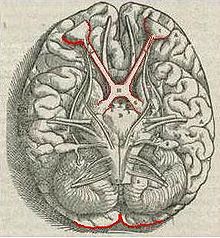
The information about the image via the eye is transmitted to the brain along the
A final population of
Optic chiasm
The optic nerves from both eyes meet and cross at the optic chiasm,
Optic tract
Information from the right visual field (now on the left side of the brain) travels in the left optic tract. Information from the left visual field travels in the right optic tract. Each optic tract terminates in the lateral geniculate nucleus (LGN) in the thalamus.
Lateral geniculate nucleus
The lateral geniculate nucleus (LGN) is a sensory relay nucleus in the thalamus of the brain. The LGN consists of six layers in
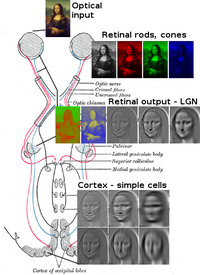
Optic radiation
The optic radiations, one on each side of the brain, carry information from the thalamic lateral geniculate nucleus to layer 4 of the visual cortex. The P layer neurons of the LGN relay to V1 layer 4C β. The M layer neurons relay to V1 layer 4C α. The K layer neurons in the LGN relay to large neurons called blobs in layers 2 and 3 of V1.[26]
There is a direct correspondence from an angular position in the visual field of the eye, all the way through the optic tract to a nerve position in V1 (up to V4, i.e. the primary visual areas. After that, the visual pathway is roughly separated into a ventral and dorsal pathway).
Visual cortex
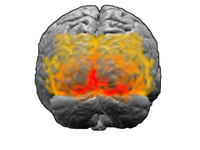
V1; V2; V3; V4; V5 (also called MT)
The visual cortex is the largest system in the human brain and is responsible for processing the visual image. It lies at the rear of the brain (highlighted in the image), above the cerebellum. The region that receives information directly from the LGN is called the primary visual cortex, (also called V1 and striate cortex). It creates a bottom-up saliency map of the visual field to guide attention or eye gaze to salient visual locations,[35] hence selection of visual input information by attention starts at V1[36] along the visual pathway. Visual information then flows through a cortical hierarchy. These areas include V2, V3, V4 and area V5/MT (the exact connectivity depends on the species of the animal). These secondary visual areas (collectively termed the extrastriate visual cortex) process a wide variety of visual primitives. Neurons in V1 and V2 respond selectively to bars of specific orientations, or combinations of bars. These are believed to support edge and corner detection. Similarly, basic information about color and motion is processed here.[37]
Heider, et al. (2002) have found that neurons involving V1, V2, and V3 can detect stereoscopic illusory contours; they found that stereoscopic stimuli subtending up to 8° can activate these neurons.[38]
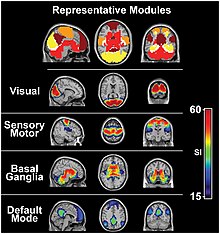
Visual association cortex
As visual information passes forward through the visual hierarchy, the complexity of the neural representations increases. Whereas a V1 neuron may respond selectively to a line segment of a particular orientation in a particular retinotopic location, neurons in the lateral occipital complex respond selectively to complete object (e.g., a figure drawing), and neurons in visual association cortex may respond selectively to human faces, or to a particular object.
Along with this increasing complexity of neural representation may come a level of specialization of processing into two distinct pathways: the
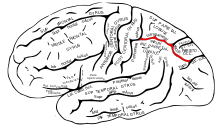
However, there is still much debate about the degree of specialization within these two pathways, since they are in fact heavily interconnected.[40]
Horace Barlow proposed the efficient coding hypothesis in 1961 as a theoretical model of sensory coding in the brain.[41] Limitations in the applicability of this theory in the primary visual cortex (V1) motivated the V1 Saliency Hypothesis that V1 creates a bottom-up saliency map to guide attention exogenously.[35] With attentional selection as a center stage, vision is seen as composed of encoding, selection, and decoding stages.[42]
The default mode network is a network of brain regions that are active when an individual is awake and at rest. The visual system's default mode can be monitored during resting state fMRI: Fox, et al. (2005) have found that "The human brain is intrinsically organized into dynamic, anticorrelated functional networks'",[43] in which the visual system switches from resting state to attention.
In the parietal lobe, the lateral and ventral intraparietal cortex are involved in visual attention and saccadic eye movements. These regions are in the Intraparietal sulcus (marked in red in the adjacent image).
Development
Infancy
Newborn infants have limited
Childhood and adolescence
Depth perception, focus, tracking and other aspects of vision continue to develop throughout early and middle childhood. From recent studies in the United States and Australia there is some evidence that the amount of time school aged children spend outdoors, in natural light, may have some impact on whether they develop myopia. The condition tends to get somewhat worse through childhood and adolescence, but stabilizes in adulthood. More prominent myopia (nearsightedness) and astigmatism are thought to be inherited. Children with this condition may need to wear glasses.
Adulthood
Vision is often one of the first senses affected by aging. A number of changes occur with aging:
- Over time, the ultraviolet light and agingare two main causes.
- The lens becomes less flexible, diminishing the ability to accommodate (presbyopia).
- While a healthy adult pupil typically has a size range of 2–8 mm, with age the range gets smaller, trending towards a moderately small diameter.
- On average tear production declines with age. However, there are a number of age-related conditions that can cause excessive tearing.
Other functions
Balance
Along with
According to Pollock et al. (2010) stroke is the main cause of specific visual impairment, most frequently visual field loss (homonymous hemianopia, a visual field defect). Nevertheless, evidence for the efficacy of cost-effective interventions aimed at these visual field defects is still inconsistent.[53]
Clinical significance
3. Homonymous hemianopsia
4. Quadrantanopia
5&6. Quadrantanopia with macular sparing
Proper function of the visual system is required for sensing, processing, and understanding the surrounding environment. Difficulty in sensing, processing and understanding light input has the potential to adversely impact an individual's ability to communicate, learn and effectively complete routine tasks on a daily basis.
In children, early diagnosis and treatment of impaired visual system function is an important factor in ensuring that key social, academic and speech/language developmental milestones are met.
Cataract is clouding of the lens, which in turn affects vision. Although it may be accompanied by yellowing, clouding and yellowing can occur separately. This is typically a result of ageing, disease, or drug use.
Glaucoma is a type of blindness that begins at the edge of the visual field and progresses inward. It may result in tunnel vision. This typically involves the outer layers of the optic nerve, sometimes as a result of buildup of fluid and excessive pressure in the eye.[54]
Scotoma is a type of blindness that produces a small blind spot in the visual field typically caused by injury in the primary visual cortex.
Quadrantanopia is a type of blindness that destroys only a part of the visual field typically caused by partial injury in the primary visual cortex. This is very similar to homonymous hemianopia, but to a lesser degree.
Prosopagnosia, or face blindness, is a brain disorder that produces an inability to recognize faces. This disorder often arises after damage to the fusiform face area.
Other animals
Different
Many
Only
Biologists have determined that humans have extremely good vision compared to the overwhelming majority of animals, particularly in daylight, though a few species have better.[63] Other animals such as dogs are thought to rely more on senses other than vision, which in turn may be better developed than in humans.[64][65]
History
In the second half of the 19th century, many motifs of the nervous system were identified such as the neuron doctrine and brain localization, which related to the neuron being the basic unit of the nervous system and functional localisation in the brain, respectively. These would become tenets of the fledgling neuroscience and would support further understanding of the visual system.
The notion that the
In 2014, a textbook "Understanding vision: theory, models, and data" [42] illustrates how to link neurobiological data and visual behavior/psychological data through theoretical principles and computational models.
See also
- Achromatopsia
- Akinetopsia
- Apperceptive agnosia
- Associative visual agnosia
- Asthenopia
- Astigmatism
- Color blindness
- Echolocation
- Computer vision
- Helmholtz–Kohlrausch effect – how color balance affects vision
- Magnocellular cell
- Memory-prediction framework
- Prosopagnosia
- Scotopic sensitivity syndrome
- Recovery from blindness
- Visual agnosia
- Visual modularity
- Visual perception
- Visual processing
References
- ^ "How the Human Eye Sees." WebMD. Ed. Alan Kozarsky. WebMD, 3 October 2015. Web. 27 March 2016.
- TechMedia Network, 10 February 2010. Web. 27 March 2016.
- ^ "How the Human Eye Works | Cornea Layers/Role | Light Rays." NKCF. The Gavin Herbert Eye Institute. Web. 27 March 2016.
- ^ Albertine, Kurt. Barron's Anatomy Flash Cards
- ^ Tillotson, Joanne. McCann, Stephanie. Kaplan's Medical Flashcards. April 2, 2013.
- ^ "Optic Chiasma." Optic Chiasm Function, Anatomy & Definition. Healthline Medical Team, 9 March 2015. Web. 27 March 2016.
- Nature Publishing Group, 21 March 2007. Web. 27 March 2016.
- Wiley Online Library. 1 June. 1989. Web. 27 March 2016.
- PMID 10567260.
- PMID 96227.
- S2CID 28796357.
- S2CID 4285683.
- ISBN 978-0-19-956466-8.
- PMID 18095285.
- ^ Catani, Marco, and Derek K. Jones. "Brain." Occipito‐temporal Connections in the Human Brain. 23 June 2003. Web. 27 March 2016.
- S2CID 44794002.
- PMID 1675266.
- PMID 7540675.
- ^ Moser, May-Britt, and Edvard I. Moser. "Functional Differentiation in the Hippocampus." Wiley Online Library. 1998. Web. 27 March 2016.
- S2CID 38463227.
- ^ Reiner, Anton, and Harvey J. Karten. "Parasympathetic Ocular Control — Functional Subdivisions and Circuitry of the Avian Nucleus of Edinger-Westphal."Science Direct. 1983. Web. 27 March 2016.
- PMID 7718233.
- ^ "The Optic Pathway - Eye Disorders". MSD Manual Professional Edition. Retrieved 18 January 2022.
- PMID 18432195.
- ^ a b Nave, R. "Light and Vision". HyperPhysics. Retrieved 2014-11-13.
- ^ a b c d e f Tovée 2008
- ^ Saladin, Kenneth D. Anatomy & Physiology: The Unity of Form and Function. 5th ed. New York: McGraw-Hill, 2010.
- ^ "Webvision: Ganglion cell Physiology". Archived from the original on 2011-01-23. Retrieved 2018-12-08.
- ^ "Calculating the speed of sight".
- ^ PMID 18082405.
- ^ OCLC 47892833.
- S2CID 46505800.
- OCLC 440896281.
- ^ Vesalius 1543
- ^ S2CID 13411369.
- S2CID 195806018.
- OCLC 42073108.
- ^ Heider, Barbara; Spillmann, Lothar; Peterhans, Esther (2002) "Stereoscopic Illusory Contours— Cortical Neuron Responses and Human Perception" J. Cognitive Neuroscience 14:7 pp.1018-29 Archived 2016-10-11 at the Wayback Machine accessdate=2014-05-18
- S2CID 33359587.
- S2CID 6817815.
- ^ Barlow, H. (1961) "Possible principles underlying the transformation of sensory messages" in Sensory Communication, MIT Press
- ^ ISBN 978-0-19-882936-2.
- PMID 15976020.
- ISBN 978-1-55642-956-9. Retrieved 4 December 2014.
- S2CID 27842977.
- S2CID 36949084.
- PMID 9184687.
- PMID 1940075.
- ^ S2CID 26286705.
- ^ PMID 15728548.
- S2CID 22219417.
- PMID 22004694.
- .
- ISBN 978-1-935555-16-2. Retrieved 15 December 2014.
- PMID 9057845.
- S2CID 39736880.
- ^ "(2018) "Peacock Mantis Shrimp" National Aquarium". Archived from the original on 2018-05-04. Retrieved 2018-03-06.
- ^ David Fleshler(10-15-2012) South Florida Sun-Sentinel Archived 2013-02-03 at archive.today,
- ^ Single-Celled Planktonic Organisms Have Animal-Like Eyes, Scientists Say
- PMID 26586760.
- PMID 28743013. cited by Evolution of fan worm eyes (August 1, 2017) Phys.org
- OCLC 192082768.
- ^ Renner, Ben (January 9, 2019). "Which species, including humans, has the sharpest vision? Study debunks old beliefs". Study Finds. Retrieved February 25, 2024.
- ^ Gibeault, Stephanie (March 22, 2018). "Do Dogs Have Self-Awareness?". American Kennel Club. Retrieved February 25, 2024.
- ^ "Animal senses: How they differ from humans". Animalpha. September 14, 2023. Retrieved February 25, 2024.
- ^ PMID 7833649.
- ^ S2CID 5247746.
Further reading
- Davison JA, Patel AS, Cunha JP, Schwiegerling J, Muftuoglu O (July 2011). "Recent studies provide an updated clinical perspective on blue light-filtering IOLs". Graefes Arch. Clin. Exp. Ophthalmol. 249 (7): 957–68. PMID 21584764.
- Hatori M, Panda S (October 2010). "The emerging roles of melanopsin in behavioral adaptation to light". Trends Mol Med. 16 (10): 435–46. PMID 20810319.
- Heiting, G., (2011). Your infant's vision Development. Retrieved February 27, 2012 from http://www.allaboutvision.com/parents/infants.htm
- Hubel, David H. (1995). Eye, brain, and vision. New York: OCLC 32806252.
- Kolb B, Whishaw I (2012). Introduction to Brain and Behaviour Fourth Edition. New York: Worth Publishers. OCLC 918592547.
- Marr, David; Ullman, Shimon; Poggio, Tomaso (2010). Vision: A Computational Investigation into the Human Representation and Processing of Visual Information. Cambridge, Mass: OCLC 472791457.
- Rodiek, R.W. (1988). "The Primate Retina". Comparative Primate Biology. Neurosciences. 4. New York: A.R. Liss.. (H.D. Steklis and J. Erwin, editors.) pp. 203–278.
- Schmolesky, Matthew (1995). "The Primary Visual Cortex". NIH National Library of Medicine. PMID 21413385.
- The Aging Eye; See into Your future. (2009). Retrieved February 27, 2012 from https://web.archive.org/web/20111117045917/http://www.realage.com/check-your-health/eye-health/aging-eye
- Tovée, Martin J. (2008). An introduction to the visual system. Cambridge, UK: OCLC 185026571.
- Vesalius, Andreas (1543). De Humani Corporis Fabrica [On the Workings of the Human Body].
- S2CID 16117515..
External links
- "Webvision: The Organization of the Retina and Visual System" – John Moran Eye Center at University of Utah
- VisionScience.com – An online resource for researchers in vision science.
- Journal of Vision – An online, open access journal of vision science.
- i-Perception – An online, open access journal of perception science.
- Hagfish research has found the "missing link" in the evolution of the eye. See: Nature Reviews Neuroscience.
- Valentin Dragoi. "Chapter 14: Visual Processing: Eye and Retina". Neuroscience Online, the Open-Access Neuroscience Electronic Textbook. The University of Texas Health Science Center at Houston (UTHealth). Archived from the original on 1 November 2017. Retrieved 27 April 2014.

